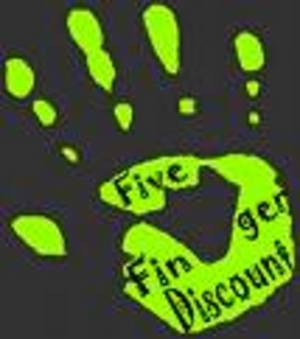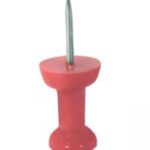It is a sad reality that innocent, honest hard-working people have to pay a high price for dishonest five finger discount specialists. These individuals have cost us the freedom of looking around retail stores at our own leisure without a salesperson watching our every move. Fitting rooms have also been added to the theft problem as retailers only allow a few garments to be tried on at one time, making your shopping trip longer then need be.
Items of higher value have been placed in glass displays under lock and key, leaving us with the problem of finding an employee to unlock the case so that we may make a purchase, and depending on the store, employee’s are not always easy to locate. Clothing cables and other theft prevention devices now adorn clothing in many top retail stores, making a shopping trip somewhat of a chore.
Unfortunately retailers have had to go to this extent in an effort to put an end to the five finger discount shopper who has no intention of purchasing anything. Sadly it is the stores and honest consumers that pay the price for this expensive addiction that affects 1 in 11 people in society. Five finger discount specialists steal nearly $10 billion worth of merchandise from stores in the United States every year which means that retailers raise their prices in an attempt to recover the money that they have lost through theft.
Five finger discount artists come from every age, race, sex, social and economic background, and according to the National Crime Prevention Council, about 25% of all the people who get caught shoplifting are between the ages of 13 and 17, and when questioned as to why they felt the need to steal, their answers were shocking, but obvious, they were bored and had nothing better to do. Others claim that peer pressure played a role in their decision to shoplift expensive clothing and gadgets as they feel the need to keep up with their classmates who wear the latest fashions and who have the latest electronic toys.
75% of five finger discount specialists that are caught in the act of shoplifting are adults. Statistics show that many of these adults are first time offenders who did not shoplift out of personal need, but instead they did it as a response to out of control pressures going on in their life at the time. A small portion of retail theft occurs from professional shoplifters who steal solely for the purpose of reselling the items for a profit, and some admit to doing it full time as a business venture.
Shoplifters come up with every excuse in the book to make themselves feel better about their reasons for doing it. The problem is that thieves don’t always stand out in a crowd, and ordinary people that you would never suspect are part of this growing problem. The most typical excuses that people put into their mind before stealing something is “This store charges too much anyway,” or “This store is so big, they won’t miss this one pair of pants.
Five finger discount specialists often steal out of need, but a higher percentage of thieves are looking to make a fast buck by reselling the stolen goods. Hot items that are on a shoplifters top priority list include: Jewelry, car stereos, computer gadgets & software, cigarettes, alcohol, lottery tickets, cd players & cd’s, television sets, designer clothing, food, and expensive shoes.
Items & Tactics Used for Shoplifting
Umbrellas: A common tactic among professional shoplifters is to keep a closed umbrella hanging on their elbow. Items can easily be dropped into the umbrella while browsing through aisles, and while leaning against a counter, thieves can slide objects into the umbrella without detection.
Folded Up or Rolled Newspapers: Smaller items can easily be placed inside of a newspaper that has been strategically rolled up, leaving a gap for the purpose of shoplifting.
Baby Strollers: This one is a great tool for diehard five finger discount specialists. A stroller will typically have blankets, toys, and other things, including the baby, which merchandise can easily be hidden under. Serious shoplifters have even gone to the trouble of building false bottoms in the stroller.
Diaper Bags: Shoplifters can easily hide items under diapers, bottles, and other miscellaneous items that a typical diaper bag holds.
Large or Specially Made Coats: A professional shoplifter cuts slits in the pocket lining of their coat, so that they can reach for items without being seen. They will always keep one hand in their pocket, and they will typically inspect an item with one hand while the other hand slips out and grabs something and pulls it back through the lining to a pocket inside of the coat.
Shopping Bags: Many shoplifters will bring in a grocery bag from another store and fill it up with items that they hide under stuff that is already in their bag. This is one reason that many stores will ask you to leave your bag at the customer service desk or they will staple your bag shut.
Fitting Rooms: A Professional thief will wear baggy or worn out clothing so that they can either hide stolen clothing under their own or simply put on the new clothes while discarding their old grubby garments. This is why you may sometimes find what appears to be used or dirty underwear, bras, socks, and other clothing that is often sold in bins.
One Employee Stores: A five finger discount artist enters the store and acts like they need something that is not displayed on the shelf. They send the stores only employee into the back room to see if there is more in stock. While the employee is searching, the thief rips off the store and is gone before the employee knows what hit him.
Crotch Walking: A theft tactic that is cleverly performed by women. They simply wear a full dress or skirt into the store; place an item between their thighs, and walk out of the business like it is any other normal shopping day. Women with stronger thighs have been known to shoplift larger ticket items like electronics.
Catching a Five Finger Discount Specialist
This is not always easy as retail establishments are faced with the problem of falsely accusing an innocent person. Employees can easily misunderstand a customer’s intentions as shoppers are often seen putting an item into their pocket or purse and the employee may not realize that the customer has brought the item into the store with them for the purpose of comparison shopping.
Another problem that stores face is customers returning items without a receipt. Many shoplifters will steal an item and attempt to return it at the customer service counter. This is always a questionable act as most consumers keep their receipt on expensive items, and the employee is left to decide if the item being returned is legitimate or not, especially when money is being requested rather then a simple equal exchange.
Employee Theft
The U.S. Chamber of Commerce reports that $50 billion dollars are lost annually due to employee theft and fraud.
The Wall Street Journal reported that up to 75% of all employees steal at least once, half of these, at lease twice.
In employee surveys conducted by academics and other specialists, as many as 43% of workers interviewed admitted stealing from their employers.
The FBI reports that employee theft is the fasting growing crime in the U.S.
The Consumer Pays for Shoplifters
The results of shoplifting, including employee and vendor theft can cost retailers billions of dollars per year. Independent retail studies have estimated that shoplifting from retail stores cost the American public an average of 33.21 billion dollars per year. Depending on the type of retail store, retail inventory loss ranges from .7%-2.2% of gross sales with the average falling around 1.70%. In fact whole retail store chains have been forced out of business due to their inability to control retail theft losses, and the reality is that the cost of these losses are eventually passed on to the consumer.




